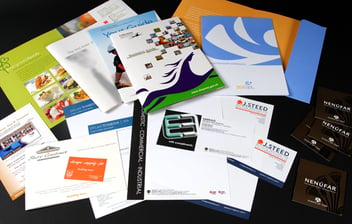Have you ever looked at print terminology and had no idea what it all meant? Did it seem like a foreign language to you? If so, you are not alone. In my blog I will share with you the basics on printing and give you enough information to be dangerous!
There are a few main things you need to know when it comes to commercial printing. Digital vs. offset printing, ink colors and paper types.
Offset vs. Digital
Offset printing is used for larger run jobs (jobs with over 500 pieces being printed), jobs that require large sheet sizes (23'x29' for example), and offset printing provides better image quality.
Digital printing is the way to go for shorter run jobs (jobs under 500 pieces). The turn time to complete digital jobs is less than those jobs run offset. Finally the ability to run variable data jobs is an advantage of digital over offset.
Ink Colors
There are 4 colors used in producing four color process printing; Cyan, Magenta, Yellow & Black. In the print industry they are referred to as CMYK. If you have a print project that include 4 colors or full color, they will be built off of a CMYK build. If your project includes a special color that can't be built off using CMYK, it will require mixing the ink colors to create what is called a PMS color. Gold and silver are a couple examples of PMS colors.
When talking about print colors, 4/0 would mean full color on the front and blank on the back. 4/4 would mean full color on both the front and back.
Paper Types
The final piece of print basics I want to share with you is the difference in paper types. There are 2 main types of paper to know; cover and text.
The main difference between the two is the thickness of the sheet. Cover is thicker and more rigid than text. I like to think of it is cover like cover of a book (thicker), and text is the pages inside the book (thinner). The thickness of cover is listed as; 65lb, 80lb and 100lb to name a few. Text options would be; 60lb, 70lb, 80lb and 100lb. The higher the lb, the thicker the paper. So 100lb text would be thicker than 60lb text.
You also have the option to put a finish on the cover of text paper stock. A few options include; gloss matte or uncoated. Gloss gives the paper a shiny look, matte is a finish not quite as shiny as gloss, an uncoated is simply that, uncoated.
There you have it, your introductory course to print basics! If you have questions, or need help with your print needs, please contact us at
sales@bluefrogdm.com.


